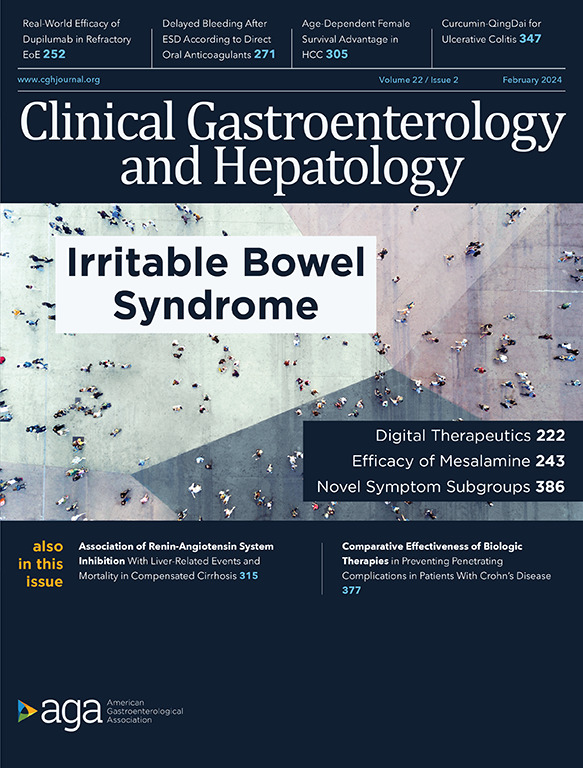Effects of Glucagon-Like Peptide-1 Receptor Agonists on Upper Gastrointestinal Endoscopy: A Meta-Analysis
IF 11.6
1区 医学
Q1 GASTROENTEROLOGY & HEPATOLOGY
引用次数: 0
Abstract
Background and Aims
Limited evidence exists regarding the impact of glucagon-like peptide-1 receptor agonists (GLP-1RAs) on upper endoscopy. Therefore, a meta-analysis was conducted to comprehensively review the available evidence on this subject.
Methods
A systematic bibliographic search was carried out until May 2024. Pooled estimates were analyzed using a random-effects model, with results presented as odds ratio (OR) and 95% confidence interval (CI). The primary outcome assessed was the rate of retained gastric content (RGC), while secondary outcomes included rates of aborted and repeated procedures, adverse event rate, and rates of aspiration.
Results
This analysis included 13 studies involving a total of 84,065 patients. Patients receiving GLP-1RA therapy exhibited significantly higher rates of RGC (OR, 5.56; 95% CI, 3.35 to 9.23), a trend that was consistent among patients with diabetes (OR, 2.60; 95% CI, 2.23 to 3.02). Adjusted analysis, accounting for variables such as sex, age, body mass index, diabetes, and other therapies, confirmed the elevated rates of RGC in the GLP-1RA user group (adjusted OR, 4.20; 95% CI, 3.42 to 5.15). Furthermore, rates of aborted and repeated procedures were higher in the GLP-1RA user group (OR, 5.13; 95% CI, 3.01 to 8.75; and OR, 2.19; 95% CI, 1.43 to 3.35; respectively). However, no significant differences were found in AE and aspiration rates between the 2 groups (OR, 4.04; 95% CI, 0.63 to 26.03; and OR, 1.75; 95% CI, 0.64 to 4.77; respectively).
Conclusion
Use of GLP-1RAs is associated with increased retention of gastric contents and more frequent aborted procedures during upper endoscopy. However, the adverse event and aspiration rates do not seem different; therefore, adjusting fasting time instead of routinely withholding GLP-1RAs could be reasonable in these patients.

胰高血糖素样肽-1 受体激动剂对上消化道内窥镜检查的影响:元分析。
背景和目的:有关胰高血糖素样肽-1受体激动剂(GLP-1RAs)对上消化道内窥镜检查影响的证据有限。因此,我们进行了一项荟萃分析,以全面审查有关这一主题的现有证据:方法:对截至 2024 年 5 月的文献进行了系统检索。采用随机效应模型对汇总的估计值进行分析,结果以几率比(OR)和 95% 置信区间(CI)表示。评估的主要结果是残留胃内容物(RGC)率,次要结果包括流产率和重复手术率、不良事件(AE)率和吸入率:该分析包括 13 项研究,共涉及 84,065 名患者。接受 GLP-1RA 治疗的患者的 RGC 发生率明显更高(OR 5.56,3.35-9.23),这一趋势与糖尿病患者一致(OR 2.60,2.23-3.02)。考虑到性别、年龄、体重指数 (BMI)、糖尿病和其他疗法等变量的调整分析证实,GLP-1RA 使用者组的 RGC 发生率较高(aOR 4.20,3.42-5.15)。此外,GLP-1RA 使用者组的流产率和重复手术率更高(OR 分别为 5.13,3.01-8.75 和 OR 2.19,1.43-3.35;)。然而,两组之间的AE和吸入率没有明显差异(OR分别为4.04,0.63-26.03和OR 1.75,0.64-4.77):结论:使用 GLP-1RAs 与胃内容物潴留增加和上内镜检查过程中更频繁的流产有关。结论:使用 GLP-1RAs 会增加胃内容物潴留,增加上内镜手术的流产率,但 AEs 和吸入率似乎并无不同,因此对这些患者而言,调整禁食时间而不是常规暂停 GLP-1RAs 是合理的。
本文章由计算机程序翻译,如有差异,请以英文原文为准。
求助全文
约1分钟内获得全文
求助全文
来源期刊
CiteScore
16.90
自引率
4.80%
发文量
903
审稿时长
22 days
期刊介绍:
Clinical Gastroenterology and Hepatology (CGH) is dedicated to offering readers a comprehensive exploration of themes in clinical gastroenterology and hepatology. Encompassing diagnostic, endoscopic, interventional, and therapeutic advances, the journal covers areas such as cancer, inflammatory diseases, functional gastrointestinal disorders, nutrition, absorption, and secretion.
As a peer-reviewed publication, CGH features original articles and scholarly reviews, ensuring immediate relevance to the practice of gastroenterology and hepatology. Beyond peer-reviewed content, the journal includes invited key reviews and articles on endoscopy/practice-based technology, health-care policy, and practice management. Multimedia elements, including images, video abstracts, and podcasts, enhance the reader's experience. CGH remains actively engaged with its audience through updates and commentary shared via platforms such as Facebook and Twitter.

 求助内容:
求助内容: 应助结果提醒方式:
应助结果提醒方式:


